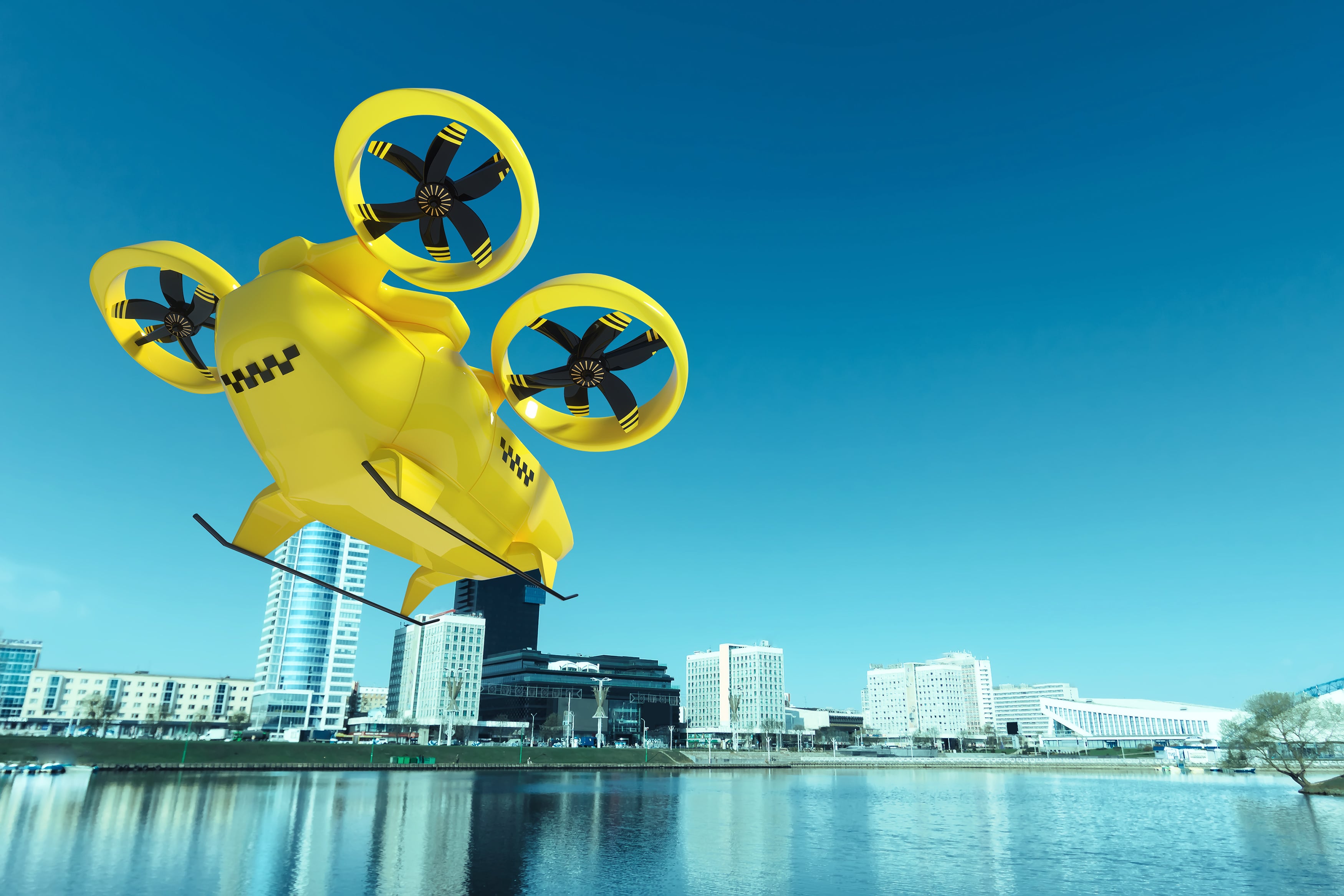Air Taxis: A New Horizon

Given all the exciting developments in the emerging urban air mobility (UAM) market, we may all soon be taking to the skies.
Everyone’s childhood dream of flight may become an everyday reality, with the flurry of investments and innovations now taking place in the eVTOL (electric vertical take-off and landing) space.
In this article, we give you a bird’s-eye view of developments in air taxis. Which industry veterans and newcomers are throwing their hats into the ring? What challenges are players in this emerging market facing as they get ready to take off?
What is an eVTOL?
eVTOL stands for electric vertical takeoff and landing. VTOL is a standard term for aircraft that can take off and land vertically, removing the need for runways. Helicopters, for example, are VTOLs. The “e” in eVTOL means the aircraft is powered by electricity and not fossil fuels--another point in the plus column for the environment.
How does an eVTOL work?
A combination of electric motors, propellers, and onboard batteries enables eVTOLs to take flight.

The players
From startups to established aerospace industry leaders, many companies are scrambling to be the first in the air. Here are some of them.
Founded in 2009 and with offices in the United States and Germany, Joby Aviation has received massive investments from the likes of Intel and Toyota. Last December, the company acquired Uber Elevate, the flying-taxi unit of the ridesharing company.
The all-electric aircraft has six rotors and is designed to carry five passengers, including the pilot. According to Joby Aviation, it can reach a top speed of 200 miles per hour and travel 150 miles on a single charge. The company aims to begin commercial taxi operations by 2024.
After more than 1,000 test flights, Joby Aviation shared footage of their all-electric aircraft last February.
German startup Volocopter is the first and only eVTOL company in the world to receive Design Organization Approval (DOA) from the European Aviation Safety Agency (EASA).
Its electric air taxi has flown over the Marina Bay in Singapore and Finland’s international airport in Helsinki. With 18 rotors powered by nine rechargeable batteries, the air taxi can carry two passengers and has a flight time of 30 minutes.
Working closely with the Economic Development Board of Singapore (EDB) and the Civil Aviation Authority of Singapore (CAAS), Volocopter aims to make air taxi services available in Singapore within the next three years.
Here’s a video of Volocopter completing its first manned flight in Singapore last 2019.
The Munich-based aviation company is currently developing a seven-seater
Lilium jet with a cruise speed of 280 kilometers per hour at 3,000 meters and a range of more than 250 kilometers.
Instead of inner-city flights, the company is focusing on providing high-speed transport for regional air mobility. It aims to provide customers with cost-effective transportation links between towns, cities, and the countryside.
Lilium has partnered with Tavistock Development Company and the City of Orlando in Florida to build the first vertiport in the United States.
According to a press release, the announcement “demonstrates Lilium’s ongoing commitment to commencing commercial operations of a quiet, emissions-free regional air mobility service, which is accessible to all, in multiple regions around the world by 2025.”
Here’s a video of the five-seater Lilium jet in flight.
Last April, American multinational parcel delivery company UPS announced plans to buy ten eVTOL aircraft from Beta Technologies (BETA).
“The BETA aircraft’s 1,400-pound cargo capacity is ideally suited to more quickly and sustainably transport time-sensitive deliveries that would otherwise fly on small fixed-wing aircraft,” the company said in a press release.
The aircraft has a 400-kilometer range and a cruising speed of up to 274 kilometers per hour, enabling UPS to plan either a series of short routes or one long route on a single charge. The first ten BETA aircraft are scheduled to begin arriving in 2024.
Here’s a video of BETA’s Alia aircraft flying from Plattsburgh airport in New York to the company’s headquarters at the Burlington International Airport in South Burlington, Vermont.
The world’s leading aircraft manufacturer is throwing its hat into the ring with the CityAirbus, currently being developed by the company’s helicopter division. The CityAirbus is a multicopter that seats four and is remotely piloted with advanced control systems. It has a cruise speed of approximately 120 kilometers per hour on fixed routes with up to 15 minutes of autonomy.
Last July, the CityAirbus performed its first fully automatic flight. Here’s a video of flight trials at the drone test center in Manching, Germany.
Wisk
“Once the design, manufacturing, and certification of electric aircraft is complete, urban air mobility companies face a cascade of logistical issues, including building an app that can connect customers to rides and finding dedicated take-off and landing areas,” says TechCrunch.
For Wisk, a joint venture between The Boeing Company and Kitty Hawk, the solution is a partnership with Blade, the digital helicopter booking platform. Wisk inked the first deal to operate autonomous air taxis in the United States last May. Wisk will own, operate, and maintain up to 30 eVTOL aircraft for the urban air mobility platform.
In addition, the two companies will form a working group to deploy technologies for “aircraft charging and next-generation air traffic management,” according to a press release.
The company is also set to conquer the sky in another continent. In February, Wisk signed a memorandum of agreement with the New Zealand government to establish “a world-first passenger transport trial” under the broader Airspace Integration Trial Programme (AITP).
Here’s a video of the company’s test flight in New Zealand.
Challenges and opportunities
In a world that has become increasingly congested on the ground, eVTOL aircraft could open up the skies for a wide range of applications that could save time, resources, and lives. They could transport passengers and cargo in a cleaner, greener, and more quiet manner. They could quickly bring police, fire, and EMS first responders to emergency locations, including those in remote areas.
To make this vision a reality, what psychological and technological challenges must the eVTOL industry overcome? Here are six challenges, as enumerated by Deloitte.

According to a 2021 report by PitchBook, a financial data and software company, the global air taxi passenger mobility market is projected to grow to USD 1.5 billion in 2025. By 2035, that figure is predicted to jump to USD 150.9 billion. This is equivalent to about 19.4% of expected global airline revenue this year.
“Although the industry faces significant technological and regulatory hurdles, we believe nontraditional investors such as manufacturers and corporates with vested interests in shaping the evolution of the transportation industry will continue to fund R&D in the space, helping drive a new wave of innovation and reshaping the aviation industry,” said Asad Hussain, Senior Analyst for Emerging Tech Research.
IMI is in a position to be a part of this new horizon. We have historical experience in communication applications integrated into smart cars as well as aeronautic expertise through our UK subsidiary, Surface Technology International (STI). Urban air mobility has the potential to redefine transportation and improve the quality of life for people around the world--helping create a faster, safer, and cleaner transportation system.
As one of the Top 21 EMS companies in the world, IMI has over 40 years of experience in providing electronics manufacturing and technology solutions.
We are ready to support your business on a global scale.
Our proven technical expertise, worldwide reach, and vast experience in high-growth and emerging markets make us the ideal global manufacturing solutions partner.
Let's work together to build our future today.
Other Blog









